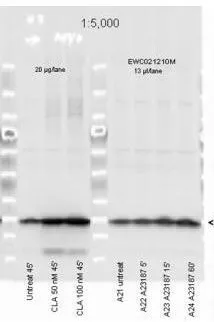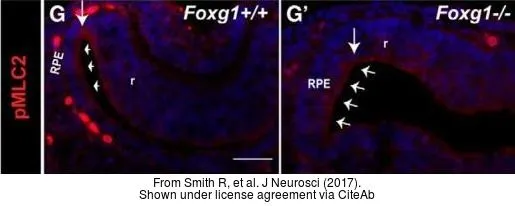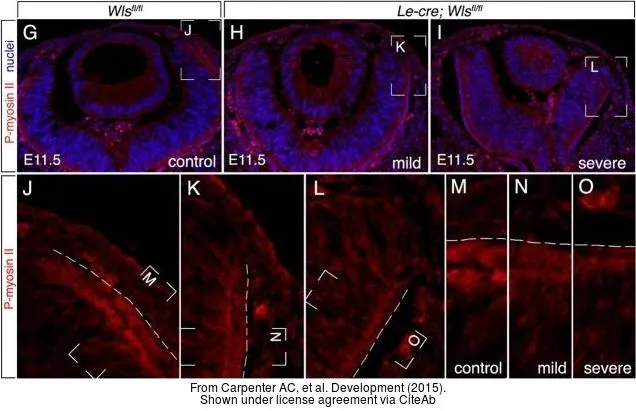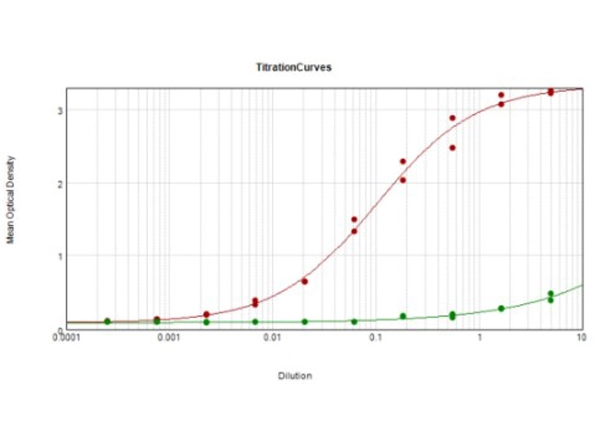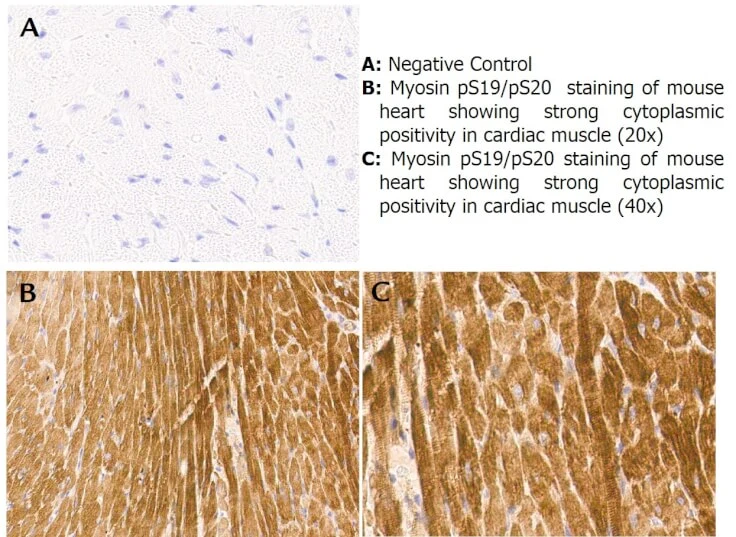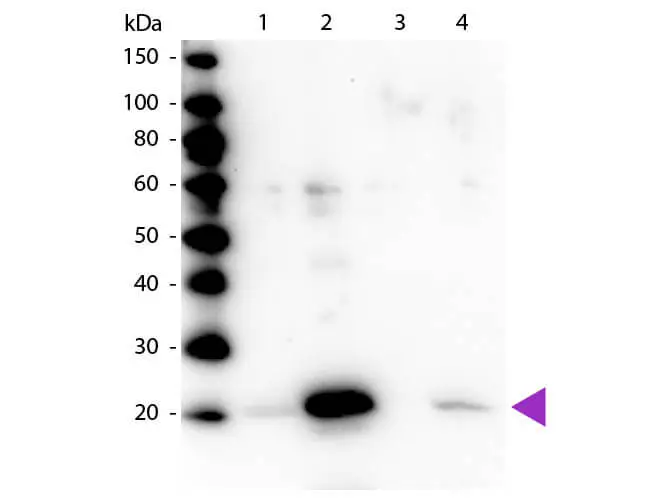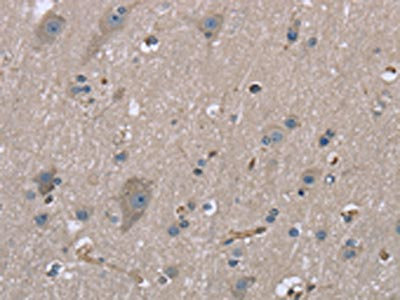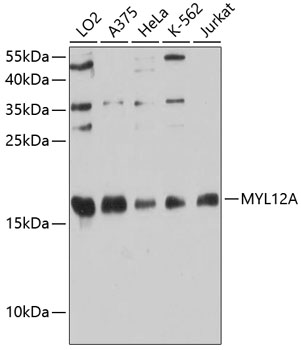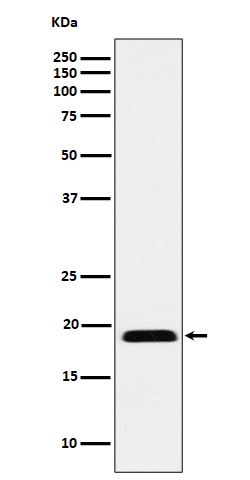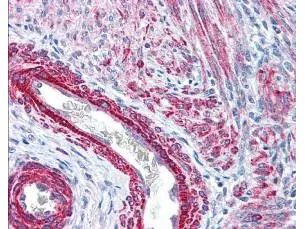
Myosin Light chain (phospho Ser20) antibody (GTX22480) was used at 2.5 microg/ml to detect signal in a variety of tissues including multi-human, multi-brain and multi-cancer slides. This image shows strong staining of both vascular and myometrial smooth muscle cells of the uterus. Tissue was formalin-fixed and paraffin embedded. The image shows localization of the antibody as the precipitated red signal, with a hematoxylin purple nuclear counterstain.
Myosin Light Chain 2 (phospho Ser19) antibody
GTX22480
ApplicationsImmunoFluorescence, ImmunoPrecipitation, Western Blot, ELISA, ImmunoCytoChemistry, ImmunoHistoChemistry, ImmunoHistoChemistry Frozen, ImmunoHistoChemistry Paraffin, Other Application
Product group Antibodies
TargetMYL12A
Overview
- SupplierGeneTex
- Product NameMyosin Light Chain 2 (phospho Ser19) antibody
- Delivery Days Customer9
- Application Supplier NoteWB: 1:500-1:2000. IHC-P: 2-5 microg/mL. IP: 1:100. ELISA: 1:10000-1:30000. *Optimal dilutions/concentrations should be determined by the researcher.Not tested in other applications.
- ApplicationsImmunoFluorescence, ImmunoPrecipitation, Western Blot, ELISA, ImmunoCytoChemistry, ImmunoHistoChemistry, ImmunoHistoChemistry Frozen, ImmunoHistoChemistry Paraffin, Other Application
- CertificationResearch Use Only
- ClonalityPolyclonal
- Concentration1.19 mg/ml
- ConjugateUnconjugated
- Gene ID10627
- Target nameMYL12A
- Target descriptionmyosin light chain 12A
- Target synonymsHEL-S-24, MLC-2B, MLCB, MRCL3, MRLC3, MYL2B, myosin regulatory light chain 12A, epididymis secretory protein Li 24, myosin RLC, myosin regulatory light chain 2, nonsarcomeric, myosin regulatory light chain 3, myosin regulatory light chain MRLC3, myosin, light chain 12A, regulatory, non-sarcomeric, myosin, light polypeptide, regulatory, non-sarcomeric (20kD)
- HostRabbit
- IsotypeIgG
- Protein IDO14950
- Protein NameMyosin regulatory light chain 12B
- Scientific DescriptionMyosin is the major component of thick muscle filaments, and is a long asymmetric molecule containing a globular head and a long tail. The molecule consists of two heavy chains each ~200,000 daltons, and four light chains each ~16,000 - 21,000 daltons. Activation of smooth and cardiac muscle primarily involves pathways that increase calcium levels and myosin phosphorylation, resulting in contraction. Myosin light chain phosphatase acts to regulate muscle contraction by dephosphorylating activated myosin light chain. This antibody is specific for the phosphorylated form of myosin light chain. The selected peptide sequence used to generate the polyclonal antibody is located near the amino terminal end of the polypeptide corresponding to the smooth/non-muscle form of myosin regulatory light chain found in cardiac myocytes in addition to smooth and non-muscle cells. This sequence differs from that of the sarcomeric/cardiac form of myosin regulatory light chain that has a different sequence around the phosphorylation site. Human and mouse have almost identical sequences. In human the phosphorylation site is pS19, while in mouse the site maps to pS20.
- Storage Instruction-20°C or -80°C,2°C to 8°C
- UNSPSC12352203
References
- Smith R, Huang YT, Tian T, et al. The Transcription Factor Foxg1 Promotes Optic Fissure Closure in the Mouse by Suppressing Wnt8b in the Nasal Optic Stalk. J Neurosci. 2017,37(33):7975-7993. doi: 10.1523/JNEUROSCI.0286-17.2017Read this paper
- Carpenter AC, Smith AN, Wagner H, et al. Wnt ligands from the embryonic surface ectoderm regulate 'bimetallic strip' optic cup morphogenesis in mouse. Development. 2015,142(5):972-82. doi: 10.1242/dev.120022Read this paper
- Plageman TF Jr, Chauhan BK, Yang C, et al. A Trio-RhoA-Shroom3 pathway is required for apical constriction and epithelial invagination. Development. 2011,138(23):5177-88. doi: 10.1242/dev.067868Read this paper
- Chauhan BK, Lou M, Zheng Y, et al. Balanced Rac1 and RhoA activities regulate cell shape and drive invagination morphogenesis in epithelia. Proc Natl Acad Sci U S A. 2011,108(45):18289-94. doi: 10.1073/pnas.1108993108Read this paper
- Chauhan BK, Disanza A, Choi SY, et al. Cdc42- and IRSp53-dependent contractile filopodia tether presumptive lens and retina to coordinate epithelial invagination. Development. 2009,136(21):3657-67. doi: 10.1242/dev.042242Read this paper


